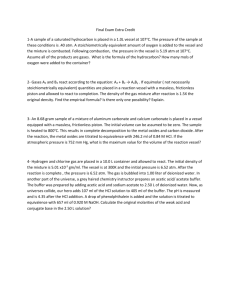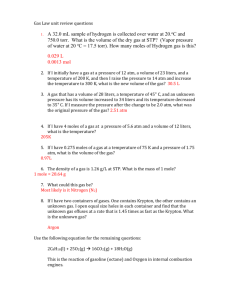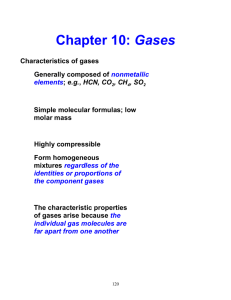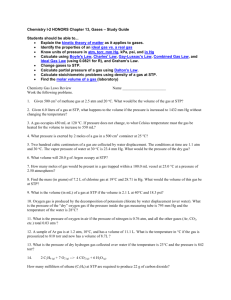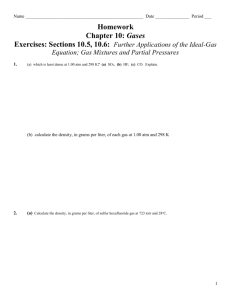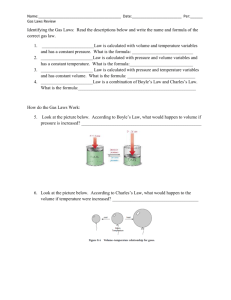Gas Laws Chemistry Problems: Lessons 12.1-12.5
advertisement
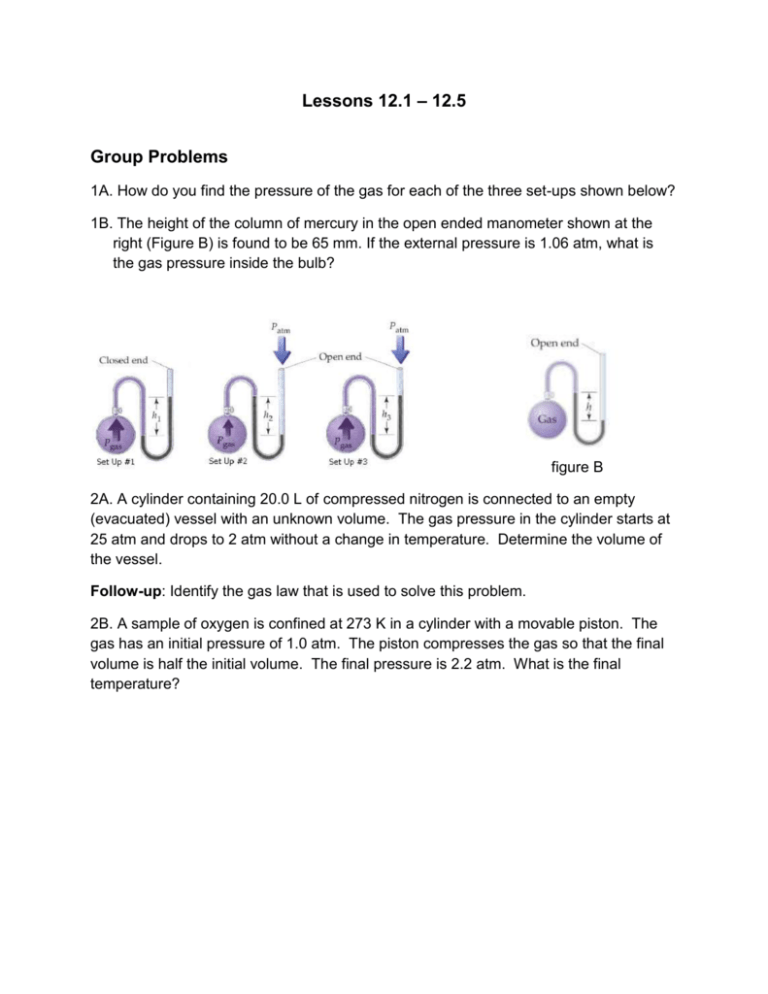
Lessons 12.1 – 12.5 Group Problems 1A. How do you find the pressure of the gas for each of the three set-ups shown below? 1B. The height of the column of mercury in the open ended manometer shown at the right (Figure B) is found to be 65 mm. If the external pressure is 1.06 atm, what is the gas pressure inside the bulb? figure B 2A. A cylinder containing 20.0 L of compressed nitrogen is connected to an empty (evacuated) vessel with an unknown volume. The gas pressure in the cylinder starts at 25 atm and drops to 2 atm without a change in temperature. Determine the volume of the vessel. Follow-up: Identify the gas law that is used to solve this problem. 2B. A sample of oxygen is confined at 273 K in a cylinder with a movable piston. The gas has an initial pressure of 1.0 atm. The piston compresses the gas so that the final volume is half the initial volume. The final pressure is 2.2 atm. What is the final temperature? 3. Which plot depicts the relationship between the volume and pressure of an ideal gas at constant n and T? V V P A V V P P P B C D Follow-up: can you draw a plot of T vs V, and n vs. V?? 4A. What conditions are represented by the abbreviation STP? 4B. What is the molar volume of a gas at STP? 4C. What is the molar volume of a gas at room temperature (25C) and 1 atm? 4D. What is the volume of 0.5 mole of an ideal gas at STP? 5A. An ideal gas in a 300 L vessel has a pressure of 560 mmHg and at 23ºC, how many moles of that gas are in the vessel? 5B. If the gas is hydrogen, what is its density? 6. A gaseous hydrocarbon has an empirical formula: CH3. The density of the gas is 1.34 g/L at STP. Determine the molecular formula of this hydrocarbon. 7A. A mixture of H2 and He are in a 10.0 L vessel at 273 K. The total pressure is 756 torr. What is the partial pressure of H2 in the vessel if XHe = 0.75? (What does XHe represent?) 7B. What is the partial pressure of He? 8. The gas in a 3.4-L flask containing CO2 at 993 mm Hg is allowed to expand into a 6.6-L flask containing N2 that was initially at a pressure of 465 mm Hg. The total volume of the combined vessels is 10.0 L. The temperature remains constant at 298 K. What is the mole fraction of CO2 in the final mixture? 9. What change or changes in the state of a gas bring about each of the following effects? A. The number of impacts per unit time on a given container wall increase. B. The average energy of impact of molecules with the wall of the container decrease. C. The average distance between gas molecules increases. D. The average speed of molecules in the gas mixture is increased. 10. It takes 21.3 s for N2 (g) to effuse from a 1.0 L container at 30oC. In a separate experiment, it takes 25.4 s for an unknown gas to effuse under identical conditions. Which of the following gases can be the unknown gas?? (Hint: what is the relationship between rate and time? Consider this before plugging numbers into any needed equations). A. Cl2, B. O2 C. Kr, D. Ar E. Ne 11. A mixture of gases at 25oC has the following mole fractions XCl2 = 0.467 , XCO= 0.346, XXe = 0.007, XN2 = 0.090, and XH2 = 0.090. Which gas has the greatest root mean square speed? A. H2 B. CO C. Xe D. N2 E. Cl2 12A. Under what conditions do real gas properties deviate from those properties predicted for an ideal gas? 12B. Which of the following gases would be most likely to exhibit ideal-gas behavior? A. He at 1 atm and 10 K B. Ne at STP C. Ar at 10 torr and 400 K D. Ne at 100 atm and 273 K E. Ar at 50 atm and 100 K 12C. Identify the ideal gas among the three that are indicated in the graph to the right. 2.0 III 1.5 II PV 1.0 RT 13. The C–Cl bond dissociation energy of CF3Cl is 339 kJ/mol. What is the maximum wavelength of photons that can rupture this bond? (Consider the following: what is the energy of one photon? What is the relationship between E and λ?) I 0.5 0.0 0 300 600 P (atm) 14. The concentration of carbon monoxide (CO) that can cause health problems is 50 ppm. If a room at 82°C and 725 torr has a total of 1.0 × 106 mol of gas and 2 × 102 mol of CO, what is the concentration (in ppm) of CO? Is this enough to cause health problems? What is the partial pressure of CO in the room? 900




